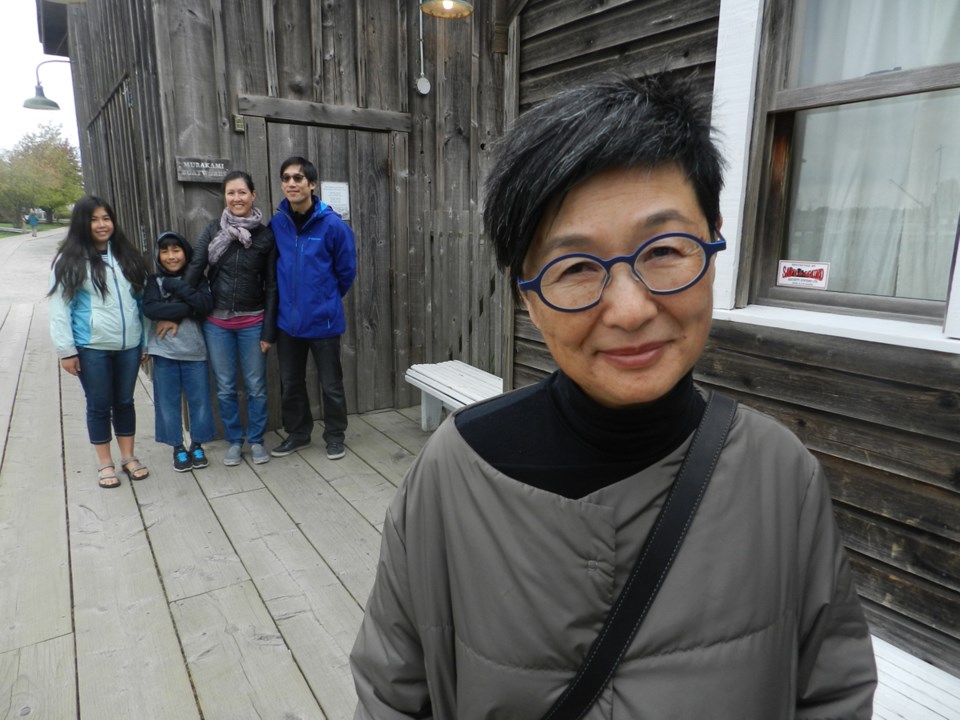There’s a disconnect in Judy Nakagawa’s family history, one she hopes her abstract sculptures will help bridge when they go on display at Britannia Heritage Shipyards starting this Saturday (Oct. 8) in a show called A Steveston Beginning: Remembering My Mother.
Nakagawa’s mother, Susie (Tsuyako) Nagakawa, was born in Steveston and lived along the waterfront near the historical site. She passed away five years ago at the age of 91.
The ties with the historic fishing village were broken when her mother’s family decided to settle in the Interior during the Second World War. While they were never interned, like many other Japanese-Canadians, when they returned to the Lower Mainland after the war, they opted to set down roots in Vancouver, leaving Judy without much information about her mom’s early life.
It took a chance walk along the Steveston waterfront at Britannia with her brother a number of years ago to broach the subject and inspire Judy to create a set of works to help fill in some of the gaps.
“My brother told me that mom was born in the area,” Judy recalled as she visited Britannia on Monday morning. “I knew she was born in Steveston, but didn’t know it was right here.
“Her dad had a fishing boat and she worked in the canneries. But I had never walked along there before.”
When she did, Judy got a strong sense of what the community must have been like for her mother, thanks to the numerous preserved buildings on the Britannia site.
“It seems that the way they’ve restored the houses, you get a good sense of how the people used to live. And the area has just such a strong personality it transported me back in time a little. Then I thought of my mother as a young, inquisitive girl,” she said. “It’s pretty amazing how I had a completely different sense of my mother growing up. She spoke very little about her early life.”
For years after that stroll with her brother, Judy felt she should do something about reconnecting with Steveston, but didn’t know exactly how or what to do.
Finally, she approached management at the shipyards and filled out a proposal for displaying her sculptures that spoke to her mother’s life.
“It took me a little while to get up the nerve to approach the site about a showing. But it just felt right.”
The proposal was accepted and, “Now, I had to do something,” she quipped, adding the show has a total of five pieces that will be displayed in the Murakami Boatworks building.
Judy received her training at the Corcoran School of Art + Design in Washington, DC, where she was awarded the 2002 Berthold Schmutzhart Award for excellence in sculpture. Her work has been exhibited in Washington DC and Vancouver, in gallery shows and as theatrical backdrops, and is on permanent display at the Japanese-Canadian National Museum in Burnaby.
“I work with wire and paper and I have some old books written in Japanese and English,” Judy said. “So, I started working those papers and the pieces sort of emerged with the material.”
One piece was created 20 years ago and characterizes three generations in her family.
“It’s three boxes and one box is for my grandfather’s generation who came to Canada. The next is my mother’s generation. And the third is my generation,” Judy said.
The others feature large, suspended sculptures that incorporate wire and paper taken from a vintage English-Japanese dictionary.
“That (using a dictionary) was how you learned English,” Judy said. “And that was a big deal when you lived in a place like this. It was your gateway to the larger culture.”
Another piece is called Learning to be English, which gives some specific insight to her mother’s life when they moved away from Steveston.
“During the war, my mother found work as a house girl for an English-speaking Canadian family who had a lot of English products in their house,” she said. “My mother saved the labels from those products, and I found them shortly after she passed away. I wanted to do something with them because they were products my mother would never have seen otherwise.”
In possibly the most personal sculpture, called Neural Navigation, Judy used a fishing net made from hemp and wire which has roughly 1,000 knots tied into it. Each knot in the net represents a neural connection her mother had, but could not respond to as she grew older and her ability to speak slipped away.
“It represents her final days in a nursing home,” she said. “She was a very articulate person, but she lost a lot of that ability. And I wanted to acknowledge that I knew there was a lot more going on than she could convey.
“That piece represents a way I could cope with her withdrawal from life.”
The show has also provided a way of properly grieving her mother’s passing, something Judy said she felt she hadn’t done properly.
“My daughter was diagnosed with breast cancer, so I was in Ottawa when my mother died, which was just wrenching for me because I didn’t expect her to pass away,” she said. “Then, a couple of months later, I had a stroke. So, that whole time was a real swirl. And a couple of years ago, I thought that I never really properly grieved her death. So, that was another reason I really felt I wanted to do something. And it gave me closure.”
A Steveston Beginning: Remembering My Mother runs Oct. 8 – 30 on Sundays and Saturdays only, from 12 – 5 p.m. at Britannia Heritage Shipyards (5180 Westwater Drive).



